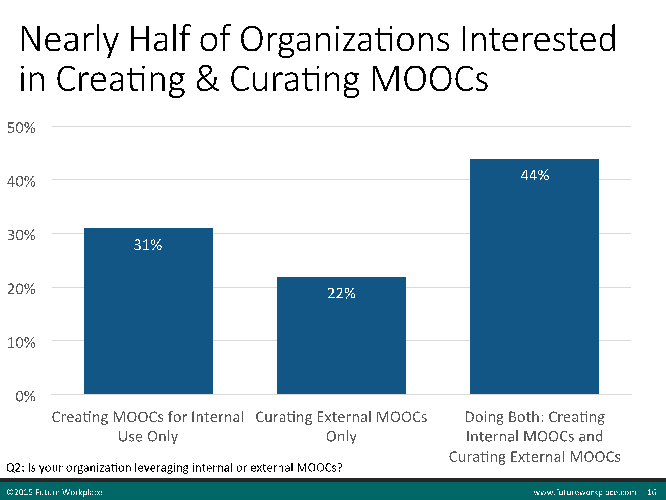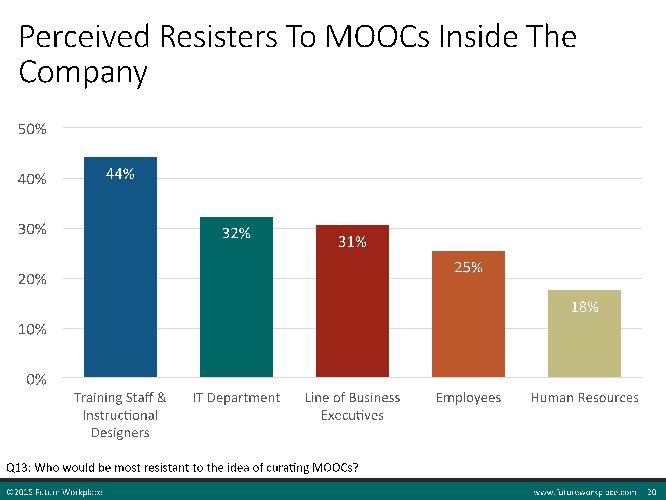MOOCs & Open Learning Assets Emerge As Disruptors To Corporate Learning
Jeanne Meister of Future Workplace talks about the growing interest that companies have in utilizing elements from MOOCs to drastically improve their corporate training.
The same approach to online learning that is used in many MOOCs may be highly beneficial for corporate training, and many companies are starting to realize this, and pilot MOOC-type approaches. Below is an article, reprinted with permission, by Jeanne Meister, a Partner at Future Workplace and co-author of the book The 2020 Workplace: How Innovative Companies Attract, Develop, and Keep Tomorrow’s Employees Today. This article was originally published on Forbes.com here.
“Big breakthroughs happen when what is suddenly possible meets what is desperately necessary.”
Three years ago, Thomas Friedman, Op-Ed Columnist for the New York Times wrote the forward looking column Come The Revolution where he summed up the disruption of MOOCs (Massive Open Online Courses) on higher education in this way: “Big breakthroughs happen when what is suddenly possible meets what is desperately necessary.” MOOCs offer not only free courses online, but also a system of testing, grading, peer-to-peer learning and certificates for completion that opens up higher education to the masses. Consider for a moment the cost of a four-year degree at a private university is over $45,000. My alma mater, University of Connecticut, where I worked to put myself through college, is now priced over $26,000 for tuition and fees. Anant Agrawal, MIT computer science professor and the CEO of the Cambridge, Massachusetts-based non-profit, edX, sees the day when learners will enroll in a series of MOOCs for their early years and then attend a brick and mortar university for the last two years. This two plus two future of higher education will result in significant disruptions for both private, public and for-profit universities.
The bar for corporate learning has been raised and the revolution is now just beginning.
But this is just the beginning of the revolution. Companies have discovered the power of the MOOCs as a new way to design and deliver online learning, where learners become peer reviewers, collaborate with each other, are highly engaged in watching short videos, participate in threaded discussion groups and some arrange local meetups to continue their learning. And for those learners who complete all the assignments, there is the ability to earn a certificate from a university and post this on their LinkedIn profile. The bar for corporate learning has been raised and the revolution is there is now just beginning. Large organizations such as; Microsoft, AT&T, and Tenaris are piloting their own custom created MOOC’s. Others such as Bank of America and Qualcomm are developing a strategy to curate publically available MOOCs aligned to their core competencies.
Our company, Future Workplace wanted to uncover how pervasive this revolution was in corporate learning. Our survey entitled Leveraging MOOCs and Open Learning Assets In The Workplace was fielded to 222 heads of Human Resources, Corporate Learning and Talent Management. We also conducted a number of interview interviews with senior HR leaders to understand the drivers behind creating a company MOOC, the benefits and barriers and the long term impact of MOOCs on corporate learning.
Four findings emerged as a wake-up call for Chief Human Resource Officers, Chief Learning Officers as well as senior business leaders.
Finding #1: MOOCs offer companies an innovative online learning design for employees plus the ability to externally offer MOOCs to attract potential new hires and new customers.
Rolando Lange, the Global Director of Tenaris University sees Tenaris continuing to develop and offer MOOCs not only to current employees but also to customers and externally to university students and potential new hires. Already Tenaris has created MOOCs on eight different topics including both technical ones such Introduction to Computer Numerical Control and Introduction to Steel as well as broad business topics such as Relationship Marketing and International Trade. “The MOOCs were first designed for internal employees but there are now being offer externally and in some cases are attracting over 4,000 students. This is our way of positioning our employer brand in the marketplace as well as offering a more innovative online learning course to employees,” says Lange.
Finding #2: Companies want to go beyond creating MOOCs to also curate a wide range of open learning assets.
Future Workplace survey Leveraging MOOCs and Open Learning Assets In The Workplace (Figure 1 below) found 44% of our sample are interested in both creating their own Corporate MOOCs as well as planning a strategy for curation of open learning assets. Karen Kocher, Chief Learning Officer of Cigna believes there is a significant opportunity to leverage MOOCs to both save money on e-learning content while also offer to Cigna employees a higher quality of self-development learning opportunities. “Our challenge today as learning officers is to think and act like an ‘intraprenuer’ within the company and be creative in re-imagining an entire suite of learning offerings.”
Finding #3: The top three barriers to experimenting with MOOCs inside companies include a lack of budget, technical and security issues and a lack of skills among corporate learning professionals to design MOOCs.
While MOOCs are marketed as “free” to students enrolled in them, for companies there is a cost to design, develop and implement MOOCs inside the enterprise. This budget will need to come from either the corporate learning budget or a business function inside the organization. In order to address the top barrier of a lack of budget, Chief Learning Officers will need to be creative in how they fund and subsequently measure a MOOC pilot. Some may recruit a business unit leader and design a MOOC around a specific business need. Others may decide to “pilot” a MOOC on a broad business topic where the company is already offering a face to face program as a way to compare overall learner satisfaction. According to Amy Rouse, Director of AT&T University Operations Training, the company decided to focus on creating their first internal MOOC on the topic of ‘Business Writing’, a course that is also taught in an in-person classroom setting and was selected because of its wide appeal. By choosing an existing class, content development was streamlined, the same instructors could be utilized, and the metrics could be compared to the in-person course. While the in-person version lasted one full day (and required travel), the corporate MOOC took about 4-6 hours over the course of a few weeks. Rouse notes that the results of the Business Writing MOOC were quite positive: the completion rate was around 80% and learning retention (as measured by a post-class assessment) was high and comparable to that seen in in-person courses.
Finding #4: Top resistors to experimenting with the MOOC model were employees in the Corporate Learning Department.
Resistance within the corporate learning department should not be surprising as universities have found similar resistance to MOOC’s from faculty. In fact as reported in The Economist, when academics at San Jose State University were asked to teach a course on social justice created by EdX, they refused, telling the professor that this could ultimately “replace professors, dismantle departments and provide a diminished education for students in public universities.” http://www.economist.com/news/special-report/21646986-online-learning-could-disrupt-higher-education-many-universities-are-resisting-it-not
While Corporate Learning staff are not the only resistors (See Figure 2) their reluctance to experiment with a new model for designing and delivering online learning may be a function of several factors ranging from lack of knowledge of the MOOC model to lack of budget to pilot a new offering or lack of executive support to create a prototype. Whatever the reason, the time is now to develop a MOOC strategy for the organization and assess the impact this will have on corporate learning and corporate recruitment.
Moving forward, the real opportunity for integrating MOOC’s into the organization is not simply to consider whether to create a Corporate MOOC or to curate MOOC’s. Both are important goals, but the larger one is to use the MOOC movement as the impetus to re-think and re-imagine how your organization designs, develops and delivers learning. It’s time we give control for learning to our learners. After all, we trust them to do their jobs, we need to trust them to learn in a manner that suits them!
Jeanne Meister is a Partner at Future Workplace and co-author of the book The 2020 Workplace: How Innovative Companies Attract, Develop, and Keep Tomorrow’s Employees Today. Register today for Jeanne’s webinar on MOOC’s In The Workplace here: Follow Jeanne on Twitter, connect with her on LinkedIn , or sign up to receive the latest Future Workplace newsletter here







